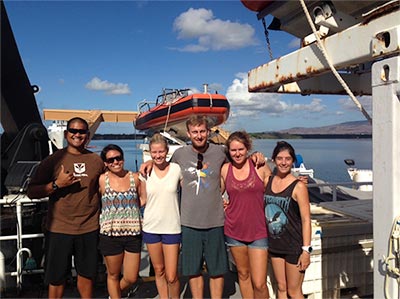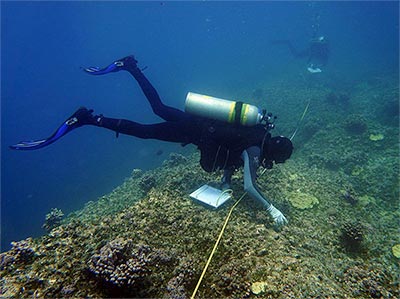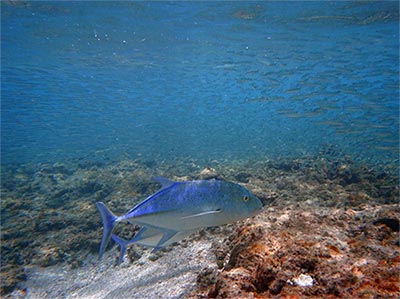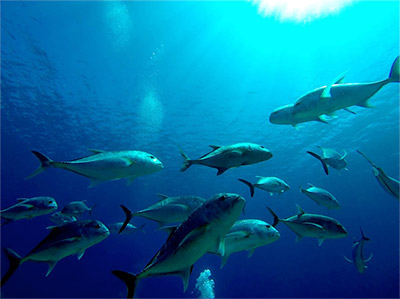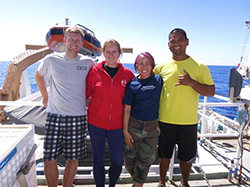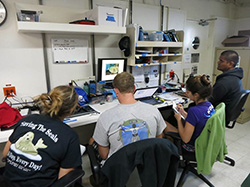The QUEST – Mentoring the Next Generation of Marine Scientists in the Northwestern Hawaiian Islands
The Reef Assessment and Monitoring Program (RAMP) 2015 expedition members are quite diverse in age and experience, with several scientists finishing their undergraduate degrees and working in Papahānaumokuākea for the first time, and others that have been coming to the Northwestern Hawaiian Islands (NWHI) for more than a decade. For one person on the maritime heritage team, this is her first time in the Pacific Ocean. This diversity provides a great range of perspectives, and for those who have been working for many years to understand and protect this place, it is a heartwarming experience to embrace and mentor the next generation of marine scientists and resource managers.
Over the years, the Monument has nurtured a close partnership with the University of Hawaiʻi Marine Option Program (MOP), and helps run its two-week intensive field training program called QUEST (Quantitative Underwater Ecological Surveying Techniques http://www.uhhmop.hawaii.edu/quest.shtml). This provides RAMP with experienced and well-trained scientists who collect data for the monitoring program; nearly all the young researchers on this expedition are QUEST graduates. These budding professionals are slated to become the next generation of scientists and resource managers to work in the Monument and help protect it. Quite a few of the students that have participated in expeditions to the Monument have gone on to get jobs at NOAA and the State of Hawaiʻi. This pioneering program is now being adapted to other places, such as American Samoa. Participants also bring their experience back home and share it with their communities and fellow students.
Following are the perspectives of some of the expedition members, both seasoned and starting out, on their experience in the Monument.
Scott Godwin, Papahānaumokuākea Marine National Monument Resource Protection Specialist and Chief Scientist for the RAMP 2015 expedition
Working in the NWHI since 1999, this is Scott’s 17th trip to what is now the Monument. His specialty is studying bottom-dwelling organisms, such as crabs and corals, but he has also led missions to remove marine debris, a project to remove a derelict sailboat from Kure Atoll, and has acted as Chief Scientist on four RAMP expeditions including this one.
Over the years, Scott says that he has seen much more openness to this place as a protected area, and greater cooperation among the agencies that work to protect and manage it. Overall, the place itself has not changed that much, but understanding of it has increased significantly.
There have also been great strides in resource management and protection and, since most people will not be able to visit it firsthand, in bringing the place to the people. Much of this has been made possible by fostering a strong relationship with keen students and emerging scientists.
Working in a Marine National Monument and UNESCO World Heritage site has provided Scott many opportunities to work with scientists from around the world, and for this he feels very fortunate. However, a highlight for him is the opportunity to mentor the next generation of marine scientists and introduce them to this place.
Rebecca Weible, Marine Biology Student at the University of Hawaiʻi-Mānoa
Rebecca is about to enter her senior year in the Marine Option Program at UH-Mānoa and works at UH's Dive Safety Office. This is her first time in the NWHI and her first time on a research cruise. She completed both the initial and advanced QUEST courses, in which previous graduates of the field school act as leaders and mentors for first-time participants.
As one of the youngest people on the cruise, she said it was a little intimidating not knowing how things are done, but added, “Everyone was so nice and nurturing, and they made it fun so I never felt out of place.” She feels really lucky to have had this experience at such a young age.
For Rebecca, this expedition to see the NWHI has been a life-changing experience and a dream come true. “It has been amazing in terms of the abundance of life, corals, fish and algae,” she said. “There is so much life we don’t see in the main Hawaiian Islands. The animals are so curious, and not scared. The ulua come right up to you.”
In addition to the incredible reefs, atolls and wildlife, Rebecca has really enjoyed working with the ship crew and other scientists, and working in the field safely while still having fun. Despite the amazing geography and wildlife, what Rebecca has enjoyed most is watching the sunrises, sunsets, the stars at night from the bow, and bioluminescence in the water.
Her favorite experience during the expedition was helping to discover a shipwreck and be the first person to set eyes on it as she descended through murky waters. While her participation in this cruise was as part of the Maritime Heritage team, she is very interested in studying fish and can see herself graduating and doing more research cruises like this.
Kailey Pascoe, Marine Science Student at the University of Hawaiʻi-Hilo
Kailey Pascoe is entering her senior year at UH-Hilo and will be doing her MOP project based upon the benthic data collected during this cruise. As part of a fall semester class, she will be analyzing data and determining if they are sufficient to do comparisons, such as between Hawaiʻi Island coral reefs and those in the NWHI.
A graduate of QUEST, earlier this year Kailey took the advanced QUEST course and won a leadership award for guiding a cadre of six students through the initial QUEST field school.
Kailey grew up in Kāneʻohe on Oʻahu and watched the reefs of Kāneʻohe Bay diminish over the years. She has seen corals in the bay bleach from thermal stress and recover, and has also witnessed the impacts from alien algae. Although she has seen bleached corals in the Monument, and some reefs overgrown by algae, she is still amazed at the amount of life, large fish and table corals at French Frigate Shoals.
“At first I was intimidated by the ulua, but after that I was just amazed,” she said. “Up here you see predators on every dive, and big schools of manini. To have the Monument protected and be able to see such abundance is pretty amazing.”
The youngest participant of this year's expedition, Kailey has learned so much from the other scientists and has enjoyed seeing what each person can add to the research efforts. Her favorite moments were seeing table corals and French Frigate Shoals, and being surrounded by ulua and sharks during one of the dives. Seeing Midway Atoll National Wildlife Refuge was also a highlight. Although it has been tiring, she wants more. In the future, she hopes to work for the Monument.
Paula Ayotte, Marine Ecosystem Research Specialist with NOAA Fisheries’ Coral Reef Ecosystem Division and RAMP 2015 Fish Team lead
Forget those Disney voices in “Finding Nemo”; if fish could talk, the voice would be that of Paula Ayotte. Paula has been working in the NWHI for 10 years, and this is Paula's 9th trip to what is now the Monument. As a diver for NOAA Fisheries’ Coral Reef Ecosystem Division, Paula also works on other NOAA RAMP expeditions across the Pacific, including those to the Line Islands, Samoa and the Mariana Islands, and participated in an expedition to Timor Leste with funding from USAID.
“Some years I only see a few sharks, and then others I see many,” said Paula. “When I'm asked how the fish populations are doing, I like to remind people that what I see or experience out there is only part of the picture. I'm only one out of a team of four, six or even more survey divers. And even if I personally don’t recollect a lot of changes in fish composition over time, the analyzed data might show a different story.”
Although Paula started scientific diving 10 years ago she is still 20 years older than many of the “kids” on this expedition. Like some of the younger scientists, Paula is a graduate of UH MOP and QUEST, but to her it seems that the students today are better trained than she was.
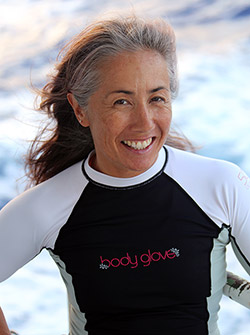
Paula Ayotte, Marine Ecosystem Research Specialist with NOAA Fisheries’ Coral Reef Ecosystem Division and RAMP 2015 Fish Team lead. Credit: NOAA
“I’m really impressed with the knowledge base these kids have, and how smart they are. They go through a week-long CRED training that I conduct – fish ID tests, homework, data entry, diving proficiency, field tests – and almost always do extremely well.” Overall, she feels like the younger participants on this expedition are more serious and more motivated than she was at that age.
One cool thing she saw this year was a fish she has not seen before in the NWHI, a sunrise wrasse, which typically is not found at recreational diving depths. Other highlights were seeing fish that she doesn't get to see in the main Hawaiian Islands, like morwongs, Japanese angels, and masked angels. Also, “just knowing that it is a Monument and that very few people get to experience it, and that it's very special place to visit.”
One member of Paula's team this year was Kalani Quiocho, and Assistant Marine Coordinator/Marine Fellow with the The Nature Conservancy. A Native Hawaiian, Kalani conducted an oli (chant) before each dive, and this helped Paula to connect with the place and remember that it means more than just being here as scientists collecting numbers.
When asked about passing the torch and training the next cadre of scientists, Paula said, “Physically, we can only do this for so long, diving three or four times a day for weeks at a time. The kids coming up have a lot of energy and are excited about it. I can feel their excitement being out here for the first time and I’m happy to give my experience to them, and then be open to their ideas, which is not always easy.”
She feels like there is a tendency in science to be averse to change. But having new techniques, perspectives and technologies can be helpful. “Delegating some leadership to the kids, such as picking sites for the day, gives them more ownership of the work they’re doing, and it's good to have some fresh blood in there,” said Paula. “The old dinosaurs can be resistant to change.”
To make the transition, it’s important to blend the ideas of the old guard with the excitement of the new guard, and in this way, move forward into the future.
Return to RAMP Expedition Log.
